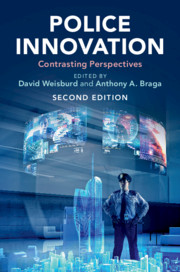Book contents
- Police Innovation
- Police Innovation
- Copyright page
- Contents
- Figures
- Tables
- Notes on Contributors
- Introduction
- Part I Community Policing
- Part II Procedural Justice Policing
- 3 Advocate
- 4 Critic
- Part III Broken Windows Policing
- Part IV Problem–Oriented Policing
- Part V Pulling Levers (Focused Deterrence) Policing
- Part VI Third–Party Policing
- Part VII Hot Spots Policing
- Part VIII Predictive Policing
- Part IX CompStat
- Part X Evidence-Based/ Risk-Focused Policing
- Part XI Technology Policing
- Index
- References
3 - Advocate
Procedural Justice Policing
from Part II - Procedural Justice Policing
Published online by Cambridge University Press: 09 August 2019
- Police Innovation
- Police Innovation
- Copyright page
- Contents
- Figures
- Tables
- Notes on Contributors
- Introduction
- Part I Community Policing
- Part II Procedural Justice Policing
- 3 Advocate
- 4 Critic
- Part III Broken Windows Policing
- Part IV Problem–Oriented Policing
- Part V Pulling Levers (Focused Deterrence) Policing
- Part VI Third–Party Policing
- Part VII Hot Spots Policing
- Part VIII Predictive Policing
- Part IX CompStat
- Part X Evidence-Based/ Risk-Focused Policing
- Part XI Technology Policing
- Index
- References
Summary
The goal of procedural justice policing is to promote long-term crime reduction through creating and maintaining widespread popular legitimacy among the people in policed communities. This trust in the police has a set of desirable consequences. First, it lowers the rate of crime because those who view the law as legitimate are less likely to break it. Second, it transforms the relationship between the police and the public from coercive to consensual, with people more likely to willingly accept and defer to police authority. Third, it promotes voluntary cooperation, facilitating police efforts to manage social order. And finally, it promotes community development by creating a climate of reassurance within which people more willingly engage with others, leading to economic, social, and political vibrancy. This climate helps communities to develop out of the conditions promoting crime, rather than trying to arrest their way forward.
- Type
- Chapter
- Information
- Police InnovationContrasting Perspectives, pp. 71 - 94Publisher: Cambridge University PressPrint publication year: 2019
References
- 4
- Cited by



